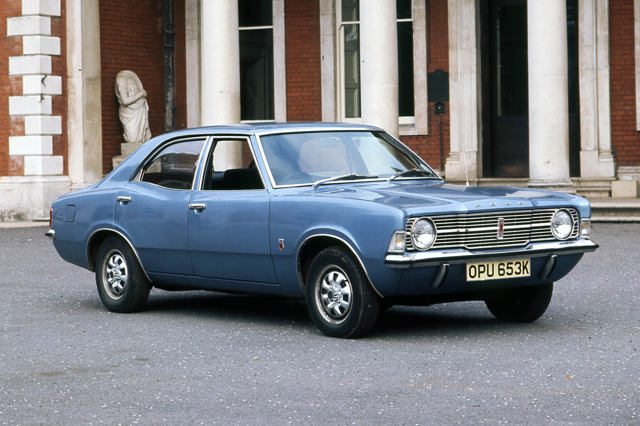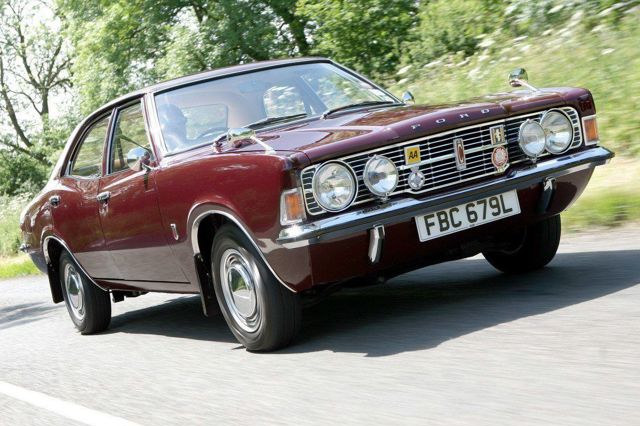Ford Cortina Mk3 (1970 – 1976) Review
Ford Cortina Mk3 (1970 – 1976) At A Glance
As hard as it is to believe now, the Cortina Mk3 (or TC for Taunus Cortina) was a massive gamble for its maker. Both the Mk1 and Mk2 were compact cars with their upper models anchored to the one-and-a-half litre class, but what Ford decided to do for their replacement was to retain the 1.3-litre entry point, but take the top models up to 2-litres, swallowing up the old Corsair range in the process. It was a cunning plan – because although it was a capable all-rounder, the Corsair had failed to set the sales charts alight, and the opportunity for Ford product planners here was to grab those sales in the two-litre market sector, hoping the Cortina magic would encourage new buyers into the fold.
Under the skin, the radical new car was a definite change in direction – so much so that there were many within Ford Product Planning who felt it deserved a new name. But the marketeers figured that as the car was such a departure from what came before, retaining the popular Cortina name was a wise move. The company was confident in its third generation car, so much so that its planned production volumes were higher than the Mk2, which was already one of the UK’s best-selling cars – but unlike the two previous generations of Cortinas, this one shared rather a lot with the German Taunus. In fact, the TC project was an Anglo-German effort that was engineered under the auspices of Harley Copp as Vice President Engineering and head of Brentwood, and incorporated rather a lot of US thinking – and not just in terms of its distinctive ‘Coke bottle’ styling.
Although the Cortina Mk3 retained the 1.3-litre Kent engine for its entry level model, the 1.6- and 2-litre versions were powered by the new overhead cam Pinto engine, which first saw service in the car of the same name Stateside. Just to confuse matters, the 1.6-litre Kent hung around for a while longer, powering the more humble model variations – with the overhead cam being reserved for the GT and GXL. The Pinto was a huge step technologically over its predecessor, not least because of its belt-driven camshaft (still a novelty in the mid-’70s), but wasn’t without subsequent issues in service. The MacPherson strut front suspension was replaced with an independent double A-arm suspension set-up, biased increasingly towards comfort. At the rear, the familiar live real axle set-up remained.
Given that the Mk3 had been conceived to replace the Corsair, it’s no surprise that it had grown significantly from the Mk2. The biggest change was in the wheelbase, which moved up to a full 100in (and that put it 4in ahead of its immediate rivals), giving the Cortina a much more commodious interior and ‘grown up’ feel that Corsair drivers took for granted. In the showroom, the Cortina also continued Ford’s policy of offering something for everyone – model variations spanned Base, L, XL, GT and GXL, and obviously spanned the widest variety of engine capacities yet. That grown up feel was no doubt also aided and abetted by the increase in weight – the 1.6-litre car (with 72bhp) was close to being a 1000kg car.
When announced at the London Motor Show in 1970, the Cortina Mk3 took the opposition completely by surprise.The only hope for the opposition was that Ford had misjudged the market and made the Cortina too big (as BMC had done with the ) – and initially it looked as if they were right. In the months following the launch, sales were slow, and disrupted by industrial action, as well as initial problems with the suspension settings and overall levels of noise, vibration and harshness (or NVH as Ford termed it), which put buyers off.
But Ford quickly reacted, sorting out the suspension issues during 1971, and the car soon bounced back. By 1973, the Cortina took its place at the head of the UK sales chart, a position it wouldn’t lose until 1982, and the year of its demise. During 1973, and a massive jump in sales. the Cortina Mk3 received a major facelift, which saw the universal adoption of the Pinto engine for the 1.6-litre models, and trim upgrades. To recreate some of that 1600E magic, a 2000E version of the Mk3 was introduced to replace the 2000GXL – and it did seem to have the desired effect of increasing sales. As for the suspension, it was further tweaked to deliver improvements in both ride and handling, most notably to tame the car’s propensity to bounce on rougher surfaces.
With the early wobbles behind it, the Mk3 went on to enjoy a six-year run, where its position as the number one fleet- and family-car seemed untenable. BL might have failed to compete with the Cortina head on with the Marina and Princess, but Vauxhall’s Cavalier looked well poised to take the fight to Ford. Except that by the time the new Griffin was launched, it was well on the way to taking another step forward with the Cortina…





.jpg?width=640&height=426&rmode=crop)
.jpg?width=640&height=426&rmode=crop)
.jpg?width=640&height=426&rmode=crop)
.jpg?width=640&height=426&rmode=crop)
.jpg?width=640&height=426&rmode=crop)


 Looks cool and was in 'Life on Mars'. Simple to fix, and get parts for.
Looks cool and was in 'Life on Mars'. Simple to fix, and get parts for.
 Rusty and not that great to drive in the smaller engined forms.
Rusty and not that great to drive in the smaller engined forms.

